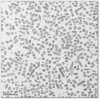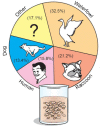Contamination of water resources by pathogenic bacteria
- PMID: 25006540
- PMCID: PMC4077002
- DOI: 10.1186/s13568-014-0051-x
Contamination of water resources by pathogenic bacteria
Abstract
Water-borne pathogen contamination in water resources and related diseases are a major water quality concern throughout the world. Increasing interest in controlling water-borne pathogens in water resources evidenced by a large number of recent publications clearly attests to the need for studies that synthesize knowledge from multiple fields covering comparative aspects of pathogen contamination, and unify them in a single place in order to present and address the problem as a whole. Providing a broader perceptive of pathogen contamination in freshwater (rivers, lakes, reservoirs, groundwater) and saline water (estuaries and coastal waters) resources, this review paper attempts to develop the first comprehensive single source of existing information on pathogen contamination in multiple types of water resources. In addition, a comprehensive discussion describes the challenges associated with using indicator organisms. Potential impacts of water resources development on pathogen contamination as well as challenges that lie ahead for addressing pathogen contamination are also discussed.
Keywords: Contamination; Pathogens; Pathogens transport; Water resources; Watershed.
Figures





Similar articles
-
Manure-borne pathogens as an important source of water contamination: An update on the dynamics of pathogen survival/transport as well as practical risk mitigation strategies.Int J Hyg Environ Health. 2020 Jun;227:113524. doi: 10.1016/j.ijheh.2020.113524. Epub 2020 Apr 13. Int J Hyg Environ Health. 2020. PMID: 32298989 Review.
-
Dioxin- and POP-contaminated sites--contemporary and future relevance and challenges: overview on background, aims and scope of the series.Environ Sci Pollut Res Int. 2008 Jul;15(5):363-93. doi: 10.1007/s11356-008-0024-1. Epub 2008 Jul 3. Environ Sci Pollut Res Int. 2008. PMID: 18597132 Review.
-
The interaction of human microbial pathogens, particulate material and nutrients in estuarine environments and their impacts on recreational and shellfish waters.Environ Sci Process Impacts. 2014 Sep 20;16(9):2145-55. doi: 10.1039/c4em00031e. Epub 2014 Jul 21. Environ Sci Process Impacts. 2014. PMID: 25043898 Review.
-
Elucidating Waterborne Pathogen Presence and Aiding Source Apportionment in an Impaired Stream.Appl Environ Microbiol. 2018 Mar 1;84(6):e02510-17. doi: 10.1128/AEM.02510-17. Print 2018 Mar 15. Appl Environ Microbiol. 2018. PMID: 29305503 Free PMC article.
-
Septic systems contribute to nutrient pollution and harmful algal blooms in the St. Lucie Estuary, Southeast Florida, USA.Harmful Algae. 2017 Dec;70:1-22. doi: 10.1016/j.hal.2017.09.005. Epub 2017 Oct 26. Harmful Algae. 2017. PMID: 29169565
Cited by
-
Human Fecal Pollution Monitoring and Microbial Risk Assessment for Water Reuse Potential in a Coastal Industrial-Residential Mixed-Use Watershed.Front Microbiol. 2021 Apr 20;12:647602. doi: 10.3389/fmicb.2021.647602. eCollection 2021. Front Microbiol. 2021. PMID: 33959110 Free PMC article.
-
Pathogen and Surrogate Survival in Relation to Fecal Indicator Bacteria in Freshwater Mesocosms.Appl Environ Microbiol. 2021 Jul 13;87(15):e0055821. doi: 10.1128/AEM.00558-21. Epub 2021 Jul 13. Appl Environ Microbiol. 2021. PMID: 34047635 Free PMC article.
-
Molecular testing devices for on-site detection of E. coli in water samples.Sci Rep. 2023 Mar 14;13(1):4245. doi: 10.1038/s41598-023-31208-4. Sci Rep. 2023. PMID: 36918634 Free PMC article.
-
Bacteriostatic impact of nanoscale zero-valent iron against pathogenic bacteria in the municipal wastewater.Biologia (Bratisl). 2021;76(9):2785-2809. doi: 10.1007/s11756-021-00814-w. Epub 2021 Jun 28. Biologia (Bratisl). 2021. PMID: 34219748 Free PMC article.
-
Assessing the Food Safety Risk Posed by Birds Entering Leafy Greens Fields in the US Southwest.Int J Environ Res Public Health. 2020 Nov 24;17(23):8711. doi: 10.3390/ijerph17238711. Int J Environ Res Public Health. 2020. PMID: 33255193 Free PMC article.
References
-
- Alley WM, Reilly TE, Franke OL. Sustainability of Groundwater Resources. U.S. Geological Survey (U.S.GS), Denver, CO; 1999.
-
- Arnone RD, Walling JP. Waterborne pathogens in urban watersheds. J Water Health. 2007;4(1):149–162. - PubMed
-
- Bai S, Lung WS. Modeling sediment impact on the transport of fecal bacteria. Water Res. 2005;4:5232–5240. - PubMed
-
- Baker-Austin C, McArthur J, Lindell A, Wright M, Tuckfield R, Gooch J, Warner L, Oliver J, Stepanauskas R. Multi-site analysis reveals widespread antibiotic resistance in the marine pathogen: Vibrio vulnificus. Microb Ecol. 2009;4(1):151–159. - PubMed
-
- Beaver JR, Crisman TL. The role of ciliated protozoa in pelagic freshwater ecosystems. Microb Ecol. 1989;4(2):111–136. - PubMed
LinkOut - more resources
Full Text Sources
Other Literature Sources

